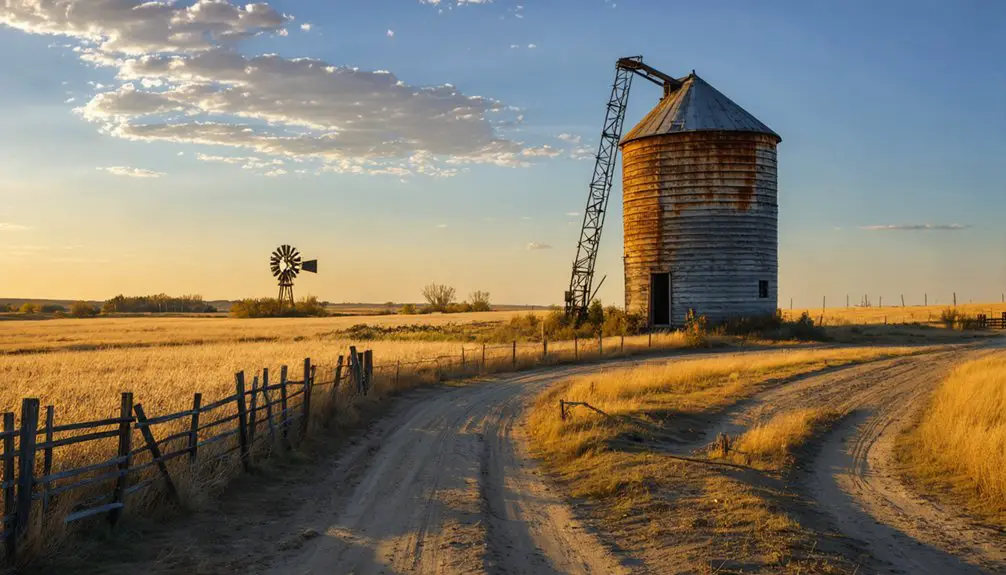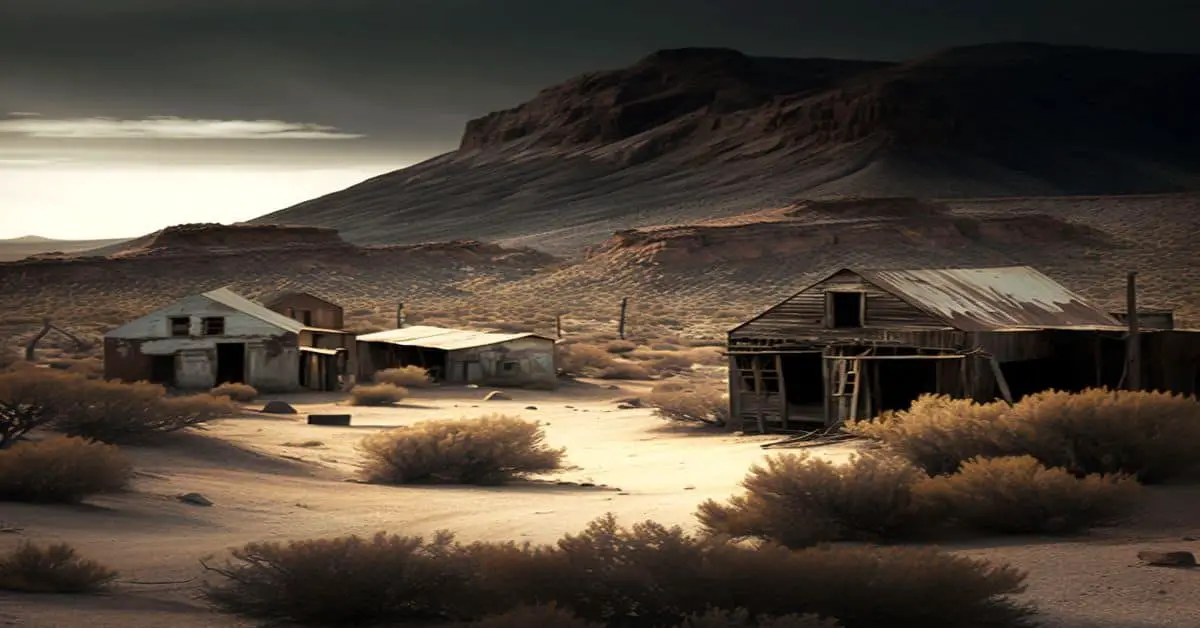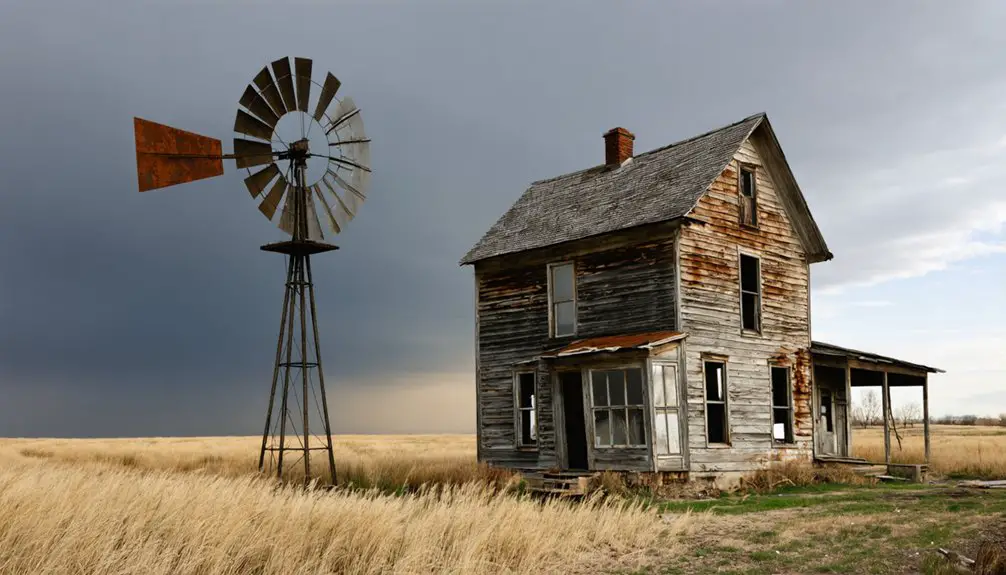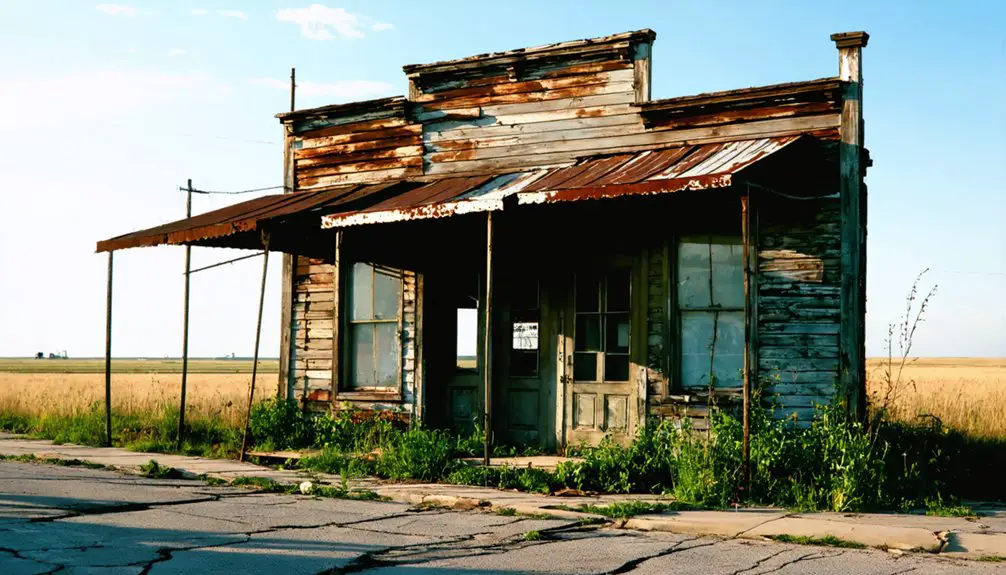You’ll find Koesterville’s remains along Nebraska’s Missouri River, where settlers established this frontier town between 1854-1860. The community thrived initially through mixed farming and local commerce, with Edgar Varney’s Pioneer Store serving as an essential hub. While the Chicago, Burlington & Quincy railroad brought promise, the town couldn’t sustain its growth when economic troubles hit in the late 1800s. Today, Morseville Cemetery‘s limestone markers tell the deeper story of this vanished settlement.
Key Takeaways
- Koesterville began as a pioneer settlement along Nebraska’s Missouri River between 1854-1860, developing into an early agricultural community.
- The town’s growth accelerated after becoming a railroad station hub, connecting rural farming communities to distant markets.
- Economic decline struck when speculative land bubbles burst in the late 1800s, causing property values to crash.
- The town’s isolation increased after losing its railroad connection, leading to the closure of its post office.
- The Morseville Cemetery remains as a historical marker, preserving the legacy of pioneer families through limestone grave markers.
The Rise of a Frontier Settlement
When settlers first arrived along Nebraska’s Missouri River between 1854 and 1860, they established critical frontier settlements that would shape the region’s development.
You’ll find that these early pioneers didn’t simply push westward, but instead followed river valleys that provided natural transportation routes and access to valuable resources.
The settlement patterns of Koesterville reflected the broader agricultural beginnings of Nebraska’s frontier towns.
Like many Nebraska frontier settlements, Koesterville’s development followed typical patterns of agricultural communities taking root in new territory.
You’d have seen crude villages spring up, with determined settlers combining subsistence living with dreams of future prosperity. They built small cabins and developed farms while establishing the social and administrative foundations needed for a permanent community.
The Missouri River location proved essential, connecting these ambitious pioneers to national markets and creating opportunities for both trade and agricultural success.
Railroad’s Role in Early Development
You’ll find that Koesterville’s growth accelerated when the railroad established a station there, transforming it into an essential transportation hub for nearby farming communities.
The rail line’s expansion through the settlement enabled local merchants to ship agricultural products to distant markets while receiving manufactured goods from eastern states. Similar to other railroad towns of the era, Koesterville experienced a significant building boom near the tracks. The Chicago, Burlington & Quincy main line played a crucial role in connecting rural communities across Nebraska.
Your understanding of the town’s early commerce must include how the railroad connected Koesterville to the national economy, making it a focal point for regional trade and development.
Transportation Hub Formation
As the railroad industry expanded across Nebraska in the late 1800s, Koesterville emerged as one of many strategic station points established by railway companies approximately seven to eight miles apart.
The town’s transportation evolution accelerated when the railroad chose this location, bypassing older settlements to maximize profits and land sales. You’d have found the hub significance apparent in how quickly businesses and housing concentrated near the tracks. Communities often provided bounties and land offers to attract railroad development to their areas.
The station became a crucial transportation nexus, connecting you to major markets like Chicago and St. Louis. Local factories and warehouses sprouted up alongside the rails, streamlining their shipping operations. Union Pacific rails reached across the entire state by 1866, further enhancing regional connectivity.
The railroad’s presence transformed Koesterville from an isolated outpost into a bustling hub where mail service, commerce, and passenger travel converged, fundamentally reshaping the region’s connectivity.
Rail Line Expansion Impact
The arrival of the Fremont, Elkhorn & Missouri Valley Railroad in 1869 dramatically transformed Koesterville’s prospects, turning the rural outpost into a magnet for development.
Regional businessmen’s railroad financing helped establish essential connections to major hubs like Omaha and Lincoln, sparking an economic transformation that rippled through the community.
You’d have witnessed the town’s rapid evolution as new settlers, including European immigrants, flocked to the area seeking opportunities.
The rail line’s presence spurred the construction of homes, hotels, and businesses near the station.
The company operated without a land grant but still managed to extend its reach from Fremont to Oakdale by 1879.
Land values soared as speculators and rail companies strategically plotted development around the tracks.
Like the Underground Railroad network that helped enslaved people escape to freedom, these rail lines created vital pathways connecting isolated communities.
Farmers and factory owners benefited from reduced shipping costs, while improved mail service accelerated communication.
The railroad’s impact reshaped Koesterville from isolated prairie to a connected frontier settlement.
Local Commerce Connections
While Koesterville’s rail station formed the heart of local commerce, surrounding businesses quickly capitalized on the new transportation hub. You’d have found a bustling network of retail shops, hotels, and livery stables positioned strategically near the tracks to serve both travelers and railroad crews.
Local trade flourished as manufacturers built warehouses alongside the rail line, reducing their shipping costs and expanding their market reach beyond Nebraska’s borders. The Union Pacific provided settlers with land at low prices to encourage development and settlement in the region.
The commerce evolution transformed Koesterville from an isolated prairie settlement into a crucial distribution point. Banks opened to finance land purchases and business ventures, while merchants stocked goods demanded by incoming settlers.
The railroad’s presence sparked a wave of immigration, bringing diverse populations that further enriched the town’s economic landscape through their specialized trades and services.
Pioneer Life and Local Commerce
Pioneer life in Koesterville began taking shape when Lewis R. Dowse staked his claim in the Middle Loup valley in 1873, followed by Frank Ohme’s homestead entry in 1874.
You’d have faced intimidating pioneer challenges: five-year residency requirements, limited timber, and the constant threat of outlaws like the Olive Gang. Like many settlers, you might have constructed a primitive sod house for shelter due to the scarcity of building materials.
To survive, you’d have relied heavily on community cooperation. The 160-acre homestead plots often weren’t enough to sustain a family, so you might’ve joined others in pooling claims, like the Chrisman sisters who combined twelve plots. Similar to how place name distinctions helped identify different territories, settlers used natural landmarks to mark their property boundaries.
You’d have found crucial supplies at Edgar Varney’s Pioneer Store, while drug stores doubled as post offices for essential communication.
Despite isolation and environmental hardships, determined settlers built a resilient community through mixed farming, ranching, and mutual support.
Notable Families and Early Settlers
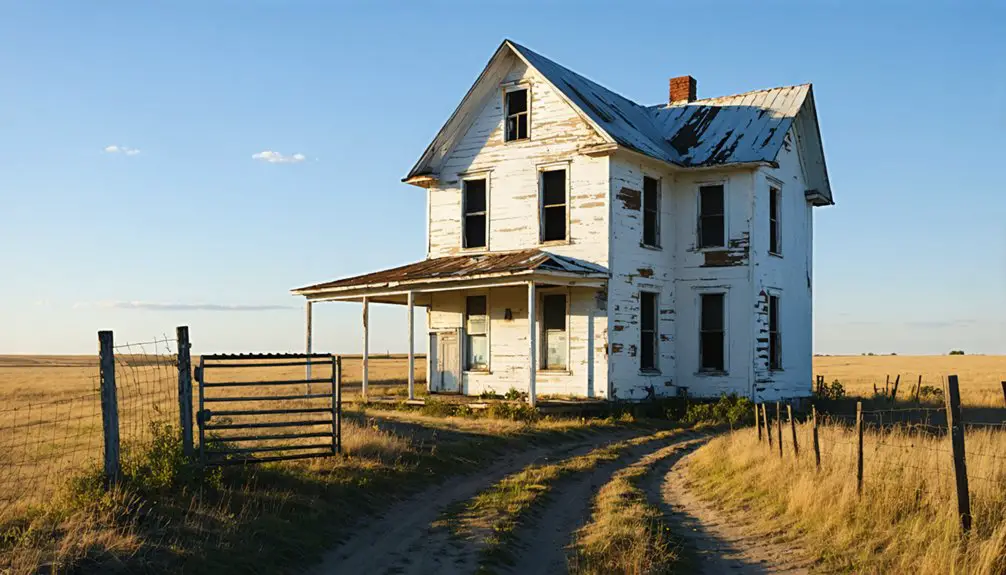
Leading the permanent settlement of Koesterville, Lewis R. Dowse blazed the trail in August 1873, establishing himself in the Middle Loup valley.
Frank Ohme followed in 1874, making the first official homestead entry in Custer County. You’ll find the legacy of other early settlers like Edward Douglas, Joseph Woods, Daniel Wagner, and Harve Andrews woven into the area’s agricultural transformation.
Early pioneers like Ohme and Douglas led Custer County’s transformation from untamed wilderness to productive farmland through their homesteading efforts.
These pioneering families shifted the region from open-range cattle operations to established farmsteads.
Judge Matthews brought legal expertise to the growing community, while the combined family contributions shaped local governance and commerce.
Black settlers, though less documented in Koesterville itself, made their mark throughout Custer County, joining the wave of homesteaders seeking independence on Nebraska’s fertile plains. The Shores and Speese families were among the notable African American pioneers who established claims in the broader Custer County region.
The Gradual Decline and Abandonment
Despite substantial initial investments in Koesterville, the town’s decline began when speculative land bubbles burst in the late 1800s. Property values crashed as investors dumped their lots at fire-sale prices, triggering a devastating chain of economic factors that would seal the town’s fate.
You’ll find that transportation played a vital role in Koesterville’s demise. Without a railroad connection, the town became increasingly isolated while nearby communities with better access flourished.
The social dynamics shifted dramatically as the post office closed and institutional support withdrew. Agricultural challenges, including drought and harsh winters, pushed many families to seek opportunities elsewhere.
Young people moved to cities, and African American homesteaders relocated westward. As schools and businesses shuttered, the remaining population dwindled until Koesterville faded into another Nebraska ghost town.
Legacy in Stone: Morseville Cemetery
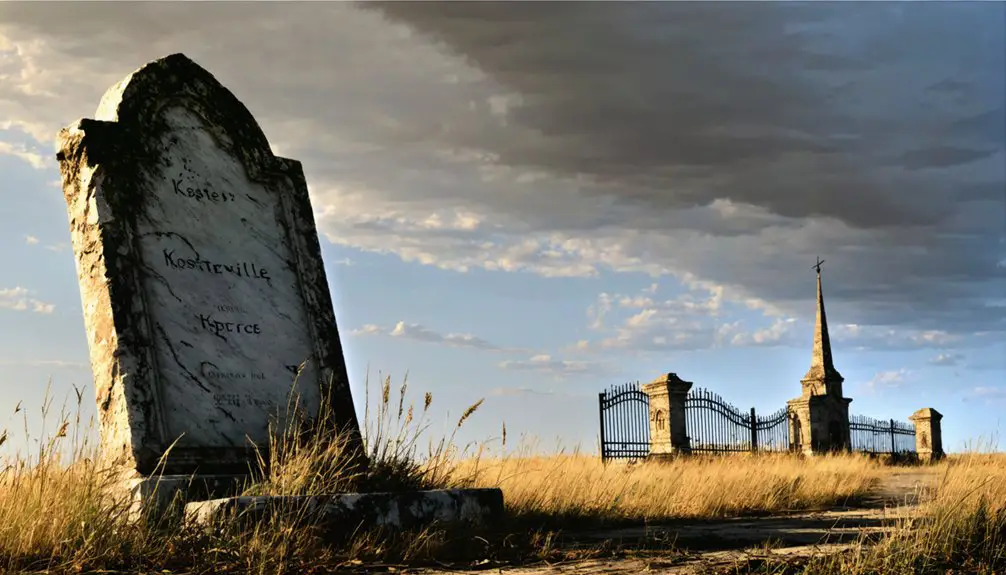
You’ll find the stories of Morseville’s pioneers etched into the weathered limestone markers that dot this historic burial ground near the intersection of four rural sections in Adams County.
These gravestones, arranged in family plots and protected by fencing from the surrounding farmland, reveal the names, dates, and relationships of the early settlers who shaped this once-thriving community.
The cemetery’s careful documentation by local historical societies guarantees these pioneer tales remain accessible to genealogists and descendants who seek to understand their ancestors’ role in Nebraska’s settlement history.
Pioneer Stories Preserved Forever
While time has erased most traces of Morseville’s existence, the community’s pioneer spirit lives on through its cemetery’s weathered stones.
You’ll find 25 to 40 grave markers telling the stories of frontier families like the Harris, Parks, Sheffield, and Morse clans who braved Nebraska’s harsh conditions in the 1870s. The pioneer narratives are etched in stone, revealing tales of remarkable settlers like Emily Parks Morse, who homesteaded alone as a widow.
These enduring monuments serve as a tribute to historical preservation, documenting the lives of those who established Morseville in Adams County’s challenging southwestern region.
Though the village has vanished, its cemetery remains a cultural touchstone, connecting you to the determination and grit of Nebraska’s early settlers.
Carving History In Limestone
Beneath Nebraska’s vast prairie skies, the limestone markers of Morseville Cemetery stand as masterful examples of 19th-century stone carving craftsmanship.
You’ll find intricate details etched by skilled artisans who used hand tools to create lasting memorials in the region’s native stone.
The limestone’s durability has preserved delicate carvings of angels, willows, and floral patterns through decades of harsh prairie weather.
Each headstone tells a story through its carved epitaphs and dates, revealing the lives of pioneer families who settled these plains.
The carving techniques varied among stonecutters, with some creating deeper inscriptions that have weathered time better than others.
These masterfully carved pieces serve as both historical documents and artistic expressions, capturing forever the spirit of Nebraska’s frontier communities in enduring limestone.
Koesterville’s Place in Adams County History
As one of many settlements that emerged during Adams County’s pivotal growth period in the 1870s, Koesterville represents a common pattern in the region’s development and decline.
Its significance in the ghost town narrative illustrates how transportation networks shaped community destinies across the plains.
You’ll find Koesterville’s story echoed in these defining aspects of Adams County’s evolution:
- Early settlement choices were driven by proximity to the Little Blue River, following pioneers like “Wild Bill” Kress.
- Railroad expansion through the county in 1871-1872 redistributed population centers.
- Communities bypassed by rail lines, like Kingston and Koesterville, faced inevitable decline.
- The Adams County Historical Society now preserves these vanished towns’ stories, documenting their role in the region’s transformation from frontier to established county.
Frequently Asked Questions
Are There Any Paranormal Activities Reported in Koesterville’s Abandoned Areas?
You won’t find documented ghost sightings or mysterious sounds in these abandoned areas, as there aren’t any verified paranormal reports from local investigators or credible eyewitnesses in available records.
What Natural Disasters or Epidemics Affected Koesterville During Its Existence?
Like footprints in shifting sand, direct records of flood damage or disease outbreaks have vanished from history. You’ll find only regional evidence of typical Great Plains disasters affecting nearby settlements.
Were There Any Native American Settlements Before Koesterville Was Established?
You’ll find that Native tribes, including Pawnee and Omaha, lived along the region’s waterways, though few historical artifacts remain from their settlements before white settlers claimed the land in the 1870s.
What Happened to the Buildings and Materials After Residents Left?
You’d find most buildings weren’t preserved but dismantled for materials. Locals salvaged timber, bricks, and nails, repurposing them into nearby farms and communities while leaving other structures to decay naturally.
Did Any Famous Outlaws or Criminals Pass Through Koesterville?
You won’t find evidence of famous outlaws or criminal activities in Koesterville’s history. Unlike other Nebraska railroad towns that attracted bandits, this small farming settlement didn’t draw notorious criminals.
References
- http://catherinescorner.net/?m
- https://history.nebraska.gov/wp-content/uploads/2011/12/doc_publications_NH2008Empire_Builders.pdf
- https://visitnebraska.com/trip-idea/explore-7-authentic-ghost-towns-nebraska
- https://www.youtube.com/watch?v=l3s2qhSxis8
- https://doninwesterville.com/author/doninwesterville/
- https://history.nebraska.gov/wp-content/uploads/2017/12/doc_publications_NH1961MissouriRFrontier.pdf
- https://nebraskalegislature.gov/pdf/bluebook/2008/60-69.pdf
- https://history.nebraska.gov/wp-content/uploads/2022/10/NH2008Empire_Builders.pdf
- https://magazine.outdoornebraska.gov/stories/history-and-culture/sod-houses-on-glass-plates/
- https://magazine.outdoornebraska.gov/stories/history-and-culture/frontier-luxury/
